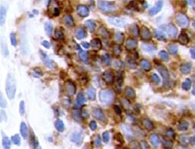Human TLR4 Antibody Summary
Glu24-Lys631
Accession # O00206
Applications
Please Note: Optimal dilutions should be determined by each laboratory for each application. General Protocols are available in the Technical Information section on our website.
Scientific Data
 View Larger
View Larger
TLR4 in Human Tonsil. TLR4 was detected in immersion fixed paraffin-embedded sections of human tonsil using Mouse Anti-Human TLR4 Monoclonal Antibody (Catalog # MAB14784) at 5 µg/mL for 1 hour at room temperature followed by incubation with the Anti-Mouse IgG VisUCyte™ HRP Polymer Antibody (VC001). Before incubation with the primary antibody, tissue was subjected to heat-induced epitope retrieval using Antigen Retrieval Reagent-Basic (CTS013). Tissue was stained using DAB (brown) and counterstained with hematoxylin (blue). Specific staining was localized to lymphocytes. Staining was performed using our protocol for IHC Staining with VisUCyte HRP Polymer Detection Reagents.
Reconstitution Calculator
Preparation and Storage
- 12 months from date of receipt, -20 to -70 °C as supplied.
- 1 month, 2 to 8 °C under sterile conditions after reconstitution.
- 6 months, -20 to -70 °C under sterile conditions after reconstitution.
Background: TLR4
TLR4 is a 100 kDa type I transmembrane glycoprotein that belongs to the mammalian Toll‑Like Receptor family of pathogen pattern recognition molecules. The complex of TLR4 with MD‑2 functions as a critical receptor for bacterial endotoxin/lipopolysaccharide (LPS) (1-3). Mature human TLR4 consists of a 608 amino acid (aa) extracellular domain (ECD), a 21 aa transmembrane segment, and a 187 aa cytoplasmic domain. TLR4 contains 21 leucine rich repeats in its ECD and one cytoplasmic Toll/IL‑1 receptor (TIR) domain (4). The ECD of human TLR4 shares approximately 25% aa sequence identity with other human TLRs and 60%-74% aa sequence identity with bovine, equine, feline, mouse, rat, and porcine TLR4. On monocytes, macrophages, dendritic cells, and B cells, MD-2 expression is required for cell surface localization of TLR4 and for optimal LPS-induced TLR4 signaling (5-8). MD-2 also forms soluble disulfide‑linked homo‑oligomers which can interact with TLR4 (6). Through a domain separate from its TLR4-binding domain, MD-2 extracts LPS from circulating CD14-LPS complexes and carries the LPS into a ternary complex with TLR4 (9-11). The interaction of MD-2/LPS with TLR4 induces receptor oligomerization and the triggering of an inflammatory response (2, 12). Increased levels of plasma MD-2 in septic shock patients sensitizes MD-2 non-expressing epithelial cells to LPS and promotes widespread tissue inflammation (13).
- Miyake, K. (2004) Semin. Immunol. 16:11.
- Verstrepen, L. et al. (2008) Cell. Mol. Life Sci. 65:2964.
- Erridge, C. (2010) J. Leukoc. Biol. 87:989.
- Medzhitov, R. et al. (1997) Nature 388:394.
- Shimazu, R. et al. (1999) J. Exp. Med. 189:1777.
- Visintin, A. et al. (2001) Proc. Natl. Acad. Sci. 98:12156.
- Akashi, S. et al. (2000) J. Immunol. 164:3471.
- Nagai, Y. et al. (2002) Nat. Immunol. 3:667.
- Re, F. and J.L. Strominger (2003) J. Immunol. 171:5272.
- Kennedy, M.N. et al. (2004) J. Biol. Chem. 279:34698.
- Gioannini, T.L. et al. (2004) Proc. Natl. Acad. Sci. 101:4186.
- Saitoh, S. et al. (2004) J. Endotoxin Res. 10:257.
- Pugin, J. et al. (2004) Blood 104:4071.
Product Datasheets
FAQs
No product specific FAQs exist for this product, however you may
View all Antibody FAQsReviews for Human TLR4 Antibody
Average Rating: 5 (Based on 1 Review)
Have you used Human TLR4 Antibody?
Submit a review and receive an Amazon gift card.
$25/€18/£15/$25CAN/¥75 Yuan/¥2500 Yen for a review with an image
$10/€7/£6/$10 CAD/¥70 Yuan/¥1110 Yen for a review without an image
Filter by:








